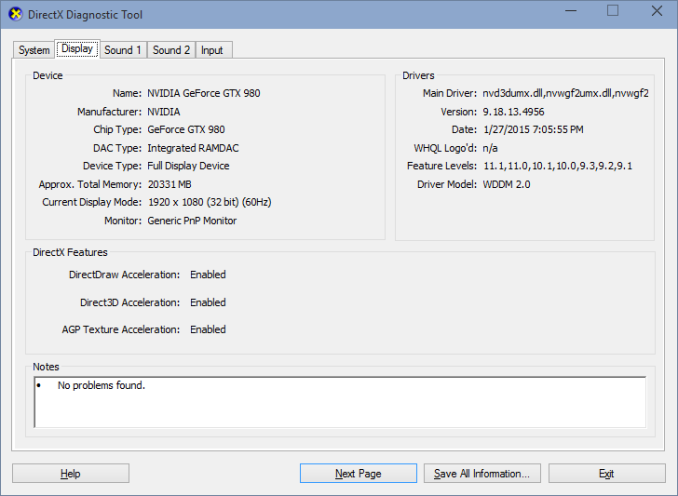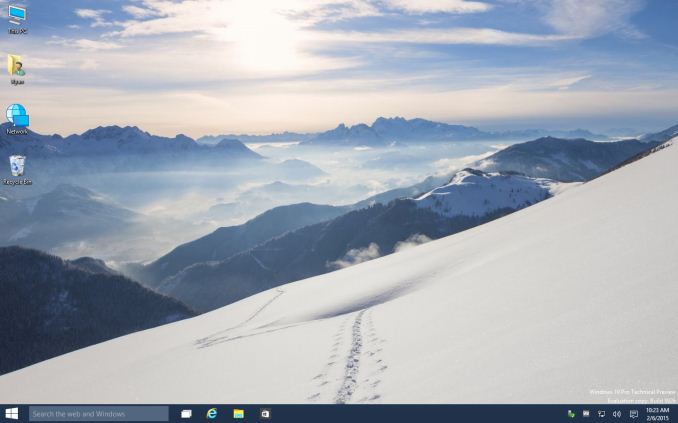The DirectX 12 Performance Preview: AMD, NVIDIA, & Star Swarm
by Ryan Smith on February 6, 2015 2:00 PM EST- Posted in
- GPUs
- AMD
- Microsoft
- NVIDIA
- DirectX 12
The Current State of DirectX 12 & WDDM 2.0
Although DirectX 12 is up and running in the latest public release of Windows 10, it and many of its related components are still under development. Windows 10 itself is still feature-incomplete, so what we’re looking at here today doesn’t even qualify as beta software. As a result today’s preview should be taken as just that: an early preview. There are still bugs, and performance and compatibility is subject to change. But as of now everything is far enough along that we can finally get a reasonable look at what DirectX 12 is capable of.
From a technical perspective the DirectX 12 API is just one part of a bigger picture. Like Microsoft’s last couple of DirectX 11 minor version upgrades, DirectX 12 goes hand-in-hand with a new version of the Windows Display Driver Model, WDDM 2.0. In fact WDDM 2.0 is the biggest change to WDDM since the driver model was introduced in Windows Vista, and as a result DirectX 12 itself represents a very large overhaul of the Windows GPU ecosystem.
Top: Radeon R9 290X. Bottom: GeForce GTX 980
Microsoft has not released too many details on WDDM 2.0 so far – more information will be released around GDC 2015 – but WDDM 2.0 is based around enabling DirectX 12, adding the necessary features to the kernel and display drivers in order to support the API above it. Among the features tied to WDDM 2.0 are DX12’s explicit memory management and dynamic resource indexing, both of which wouldn’t have been nearly as performant under WDDM 1.3. WDDM 2.0 is also responsible for some of the baser CPU efficiency optimizations in DX12, such as changes to how memory residency is handled and how DX12 applications can more explicitly control residence.
The overhauling of WDDM for 2.0 means that graphics drivers are impacted as well as the OS, and like Microsoft, NVIDIA and AMD have been preparing for WDDM 2.0 with updated graphics drivers. These drivers are still a work in progress, and as a result not all hardware support is enabled and not all bugs have been worked out.
| DirectX 12 Support Status | ||||
| Current Status | Supported At Launch | |||
| AMD GCN 1.2 (285) | Working | Yes | ||
| AMD GCN 1.1 (290/260 Series) | Working | Yes | ||
| AMD GCN 1.0 (7000/200 Series) | Buggy | Yes | ||
| NVIDIA Maxwell 2 (900 Series) | Working | Yes | ||
| NVIDIA Maxwell 1 (750 Series) | Working | Yes | ||
| NVIDIA Kepler (600/700 Series) | Working | Yes | ||
| NVIDIA Fermi (400/500 Series) | Not Active | Yes | ||
In short, among AMD and NVIDIA their latest products are up and running in WDDM 2.0, but not on all of their earlier products. In AMD’s case GCN 1.0 cards are supported under their WDDM 2.0 driver, but we are encountering texturing issues in Star Swarm that do not occur with GCN 1.1 and later. Meanwhile in NVIDIA’s case, as is common for NVIDIA beta drivers they only ship with support enabled for their newer GPUs – Kepler, Maxwell 1, and Maxwell 2 – with Fermi support disabled. Both AMD and NVIIDA have already committed to supporting DirectX 12 (and by extension WDDM 2.0) on GCN 1.0 and later and Fermi and later respectively, so while we can’t test these products today, they should be working by the time DirectX 12 ships.
Also absent for the moment is a definition for DirectX 12’s Feature Level 12_0 and DirectX 11’s 11_3. Separate from the low-level API itself, DirectX 12 and its high-level counterpart DirectX 11.3 will introduce new rendering features such as volume tiled resources and conservative rasterization. While all of the above listed video cards will support the DirectX 12 low-level API, only the very newest video cards will support FL 12_0, and consequently be fully DX12 compliant on both a feature and API basis. Like so many other aspects of DirectX 12, Microsoft is saving any discussion of feature levels for GDC, at which time we should find out what the final feature requirements will be and which (if any) current cards will fully support FL 12_0.
Finally, with Microsoft’s announcement of their Windows 10 plans last month, Microsoft is also finally clarifying their plans for the deployment of DirectX 12. Because DirectX 12 and WDDM 2.0 are tied at the hip, and by extension tied to Windows 10, DirectX 12 will only be available on Windows 10. Windows 8/8.1 and Windows 7 will not be receiving DirectX 12 support.
| DirectX 12 Supported OSes | ||||
| Will Support DX12? | Required WDDM Version | |||
| Windows 10 | Yes | 2.0 | ||
| Windows 8.1 | No | N/A | ||
| Windows 8 | No | N/A | ||
| Windows 7 | No | N/A | ||
Backporting DirectX 12 to earlier OSes would require backporting WDDM 2.0 as well, which brings with it several issues due to the fact that WDDM 2.0 is a kernel component. Microsoft would either have to compromise on WDDM 2.0 features in order to make it work on these older kernels, or alternatively would have to more radically overhaul these kernels to accommodate the full WDDM 2.0 feature set, the latter of which is a significant engineering task and carries a significant risk of breaking earlier Windows installations. Microsoft has already tried this once before in backporting parts of Direct3D 11.1 and WDDM 1.2 to Windows 7, only to discover that even that smaller-scale project had compatibility problems. A backport of DirectX 12 would in turn be even more problematic.
The bright side of all of this is that with Microsoft’s plans to offer Windows 10 as a free upgrade for Windows 7/8/8.1 users, the issue is largely rendered moot. Though DirectX 12 isn’t being backported, Windows users will instead be able to jump forward for free, so unlike Windows 8 this will not require spending money on a new OS just to gain access to the latest version of DirectX. This in turn is consistent with Microsoft’s overall plans to bring all Windows users up to Windows 10 rather than letting the market get fragmented among different Windows versions (and risk repeating another XP), so the revelation that DirectX 12 will not get backported has largely been expected since Microsoft’s Windows 10 announcement.
Meanwhile we won’t dwell on the subject too much, but DirectX 12 being limited to Windows 10 does open up a window of opportunity for Mantle and OpenGL Next. With Mantle already working on Windows 7/8 and OpenGL Next widely expected to be similarly portable, these APIs will be the only low-level APIs available to earlier Windows users.













245 Comments
View All Comments
junky77 - Friday, February 6, 2015 - link
Looking at the CPU scaling graphs and CPU/GPU usage, it doesn't look like the situation in other games where CPU can be maxed out. It does seem like this engine and test might be really tailored for this specific case of DX12 and Mantle in a specific wayThe interesting thing is to understand whether the DX11 performance shown here is optimal. The CPU usage is way below max, even for the one core supposedly taking all the load. Something is bottlenecking the performance and it's not the number of cores, threads or clocks.
eRacer1 - Friday, February 6, 2015 - link
So the GTX 980 is using less power than the 290X while performing ~50% better, and somehow NVIDIA is the one with the problem here? The data is clear. The GTX 980 has a massive DX12 (and DX11) performance lead and performance/watt lead over 290X.The_Countess666 - Thursday, February 19, 2015 - link
it also costs twice as much.and this is the first time in roughly 4 generations that nvidia's managed to release a new generation first. it would be shocking is there wasn't a huge performance difference between AMD and nvidia at the moment.
bebimbap - Friday, February 6, 2015 - link
TDP and power consumption are not the same thing, but are relatedif i had to write a simple equation it would be something to the effect of
TDP(wasted heat) = (Power Consumption) X (process node coeff) X (temperature of silicon coeff) X (Architecture coeff)
so basically TDP or "wasted heat" is related to power consumption but not the same thing
Since they are on the same process node by the same foundry, the difference in TDP vs power consumed would be because of Nvidia currently has the more efficient architecture, and that also leads to their chips being cooler, both of which lead to less "wasted heat"
A perfect conductor would have 0 TDP and infinite power consumption.
Mr Perfect - Saturday, February 7, 2015 - link
Erm, I don't think you've got the right term there with TDP. TDP is not defined as "wasted heat", but as the typical power draw of the board. So if TDP for the GTX 980 is 165 watts, that just means that in normal gaming use it's drawing 165 watts.Besides, if a card is drawing 165watts, it's all going to become heat somewhere along the line. I'm not sure you can really decide how many of those watts are "wasted" and how many are actually doing "work".
Wwhat - Saturday, February 7, 2015 - link
No, he's right TDP means Thermal design power and defines the cooling a system needs to run at full power.Strunf - Saturday, February 7, 2015 - link
It's the same... if a GC draws 165W it needs a 165W cooler... do you see anything moving on your card exept the fans? no, so all power will be transformed into heat.wetwareinterface - Saturday, February 7, 2015 - link
no it's not the same. 165w tdp means the cooler has to dump 165w worth of heat.165w power draw means the card needs to have 165w of power available to it.
if the card draws 300w of power and has 200w of heat output that means the card is dumping 200w of that 300w into the cooler.
Strunf - Sunday, February 8, 2015 - link
It's impossible for the card to draw 300W and only output 200W of heat... unless of course now GC defy the laws of physics.grogi - Sunday, April 5, 2015 - link
What is it doing with the remaining 100W?